|
Ein gut ausgestattetes Equipment auf aktuellem Stand der Technik ist von hoher Bedeutung für unsere Forschung! Daher wird die Ausstattung regelmäßig erweitert oder erneutert. Diese Liste zeigt die neu beschafften Geräte in den letzten Jahren und gibt eine kurze Beschreibung. |
NMR Spectroscopy (Medium Field, 90 MHz) [Start of Operation July 2023]
Spinsolve 90, Magritek
The Magritek Spinsolve 90 NMR spectrometer (Permanent magnet of 2.1 Tesla) sets a new standard for NMR instruments. Inspite to the Spinsolve 80 spectrometer, we choose a configuration for 13C and 1H-NMR Spectra. In addition, the machine also allows pulsed gradients (ca 0.5 T/m). In Summary, this machine allows classcial 13C and 1H spectra offering a resolution sufficient for typical polymer spectra and a high sensitivity (SN ca. 240:1, 1%). The pulsed gradient allows additional possibilities: Advanced solvent suppression methods in case you want to combine the NMR with a HPLC separation or offering the possibilities to measure many 2D-Spectra, one example is 2D-DOSY offering the posssibility to measure diffusion coefficients and teh the calculation of molecular weight diistribution without the need of a separation by a colum.
Stress Strain Maschine [Start of Operation July 2021]
Universal tensile testing machine 10kN from Hegewald & Peschke
With this machine, we completed our equipment for mechanical testing of polymeric materials: Capillary rheology for fluids (viscous materials: dynamic viscosity), Tensile Testing for Solids (elastic materials classical E-Modulus) and shear rheology or DMTA for viscoelastic materials determinating the complex E-Modulus.
Suitable for polymer testing:
Oven -70 to 250°C
Long elongation path needed for ductile polymers
Static Testing:
Testing conditions according to DIN
Brittle and ductile materials
Break detection
Dynamic testing:
Arbitary waveform
Dynamic fatigue testing with large deformation amplitudes (>>1cm)
Strain and force controlled
Raw data can be recorded
NMR Spectroscopy (Medium Field, 80 MHz) [Start of Operation July 2020]
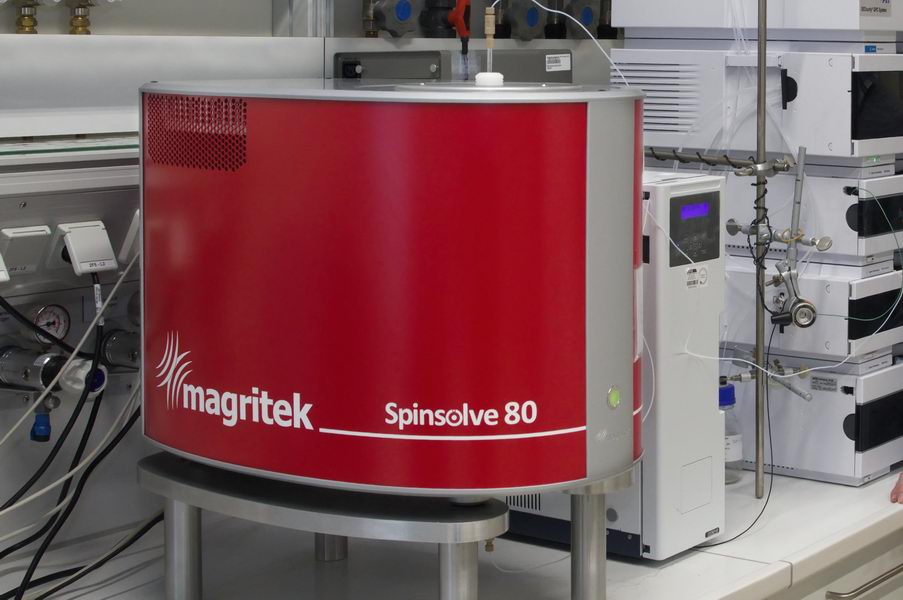
Spinsolve 80, Magritek
The Magritek Spinsolve 80 NMR spectrometer sets a new standard for NMR instruments. The Spinsolve 80 spectrometer provides high quality 1H NMR spectra in seconds and is based on permanent magnets, therefore no liquid nitrogen or helium is needed for the operation. The Sensitivity is high due to the optimization of all components for only 1H NMR Spectra. The main idea for this spectrometer is the usage in combination with GPC as the Magritec is also able to measure samples in flow. With this combination, we plan to build up a two dimensional charaterisation GPC-NMR, with size resolution due to the GPC and chemical information due to the NMR.
Static and Dynamic Light Scattering [Start of Operation Oct 2019]
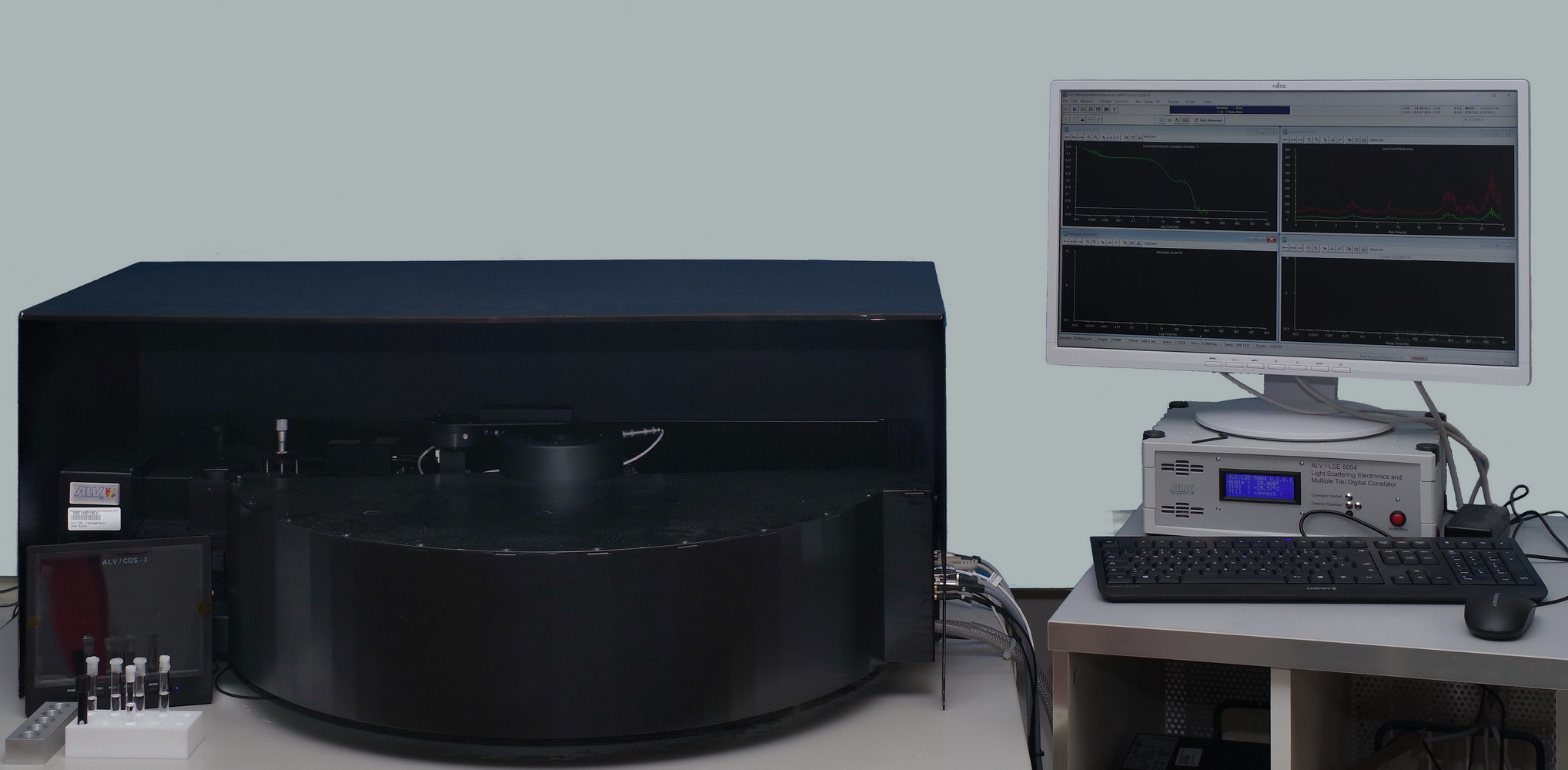 The combined instruments for Static- and Dynamic Light Scattering from ALV, Germany offers full flexibility for polymer characterization: Static Scattering for Molecular Weight, Radius of gyration an virail coefficient or the determination of Theta Solvents, Dynamic light scattering for hydrodynamic radius, solvent quality or control of aggregation processes in solution.
The combined instruments for Static- and Dynamic Light Scattering from ALV, Germany offers full flexibility for polymer characterization: Static Scattering for Molecular Weight, Radius of gyration an virail coefficient or the determination of Theta Solvents, Dynamic light scattering for hydrodynamic radius, solvent quality or control of aggregation processes in solution.
The systems is equipped with an extremely strong laser from Cobalt Inc allowing the charaterization from small concentration, the different measurement cells allows volumnia starting from 0.2 ml (only dynamic light scattering), the temperature range is extended up to 90 °C.
High Pressure Batch Foaming System [Start of operation Dez 2018]
Our batch reator is an custum build SFT-High Pressure Reactor from Supercritical Fluid Technologies.
High pressure 100 ml stainless steel vessel with supercritical fluid pump and temperature control unit for batch foaming experiments operating with scCO2 up to 10,000 psi (690 bar) and a max. temperature of 200 °C. Nucleation can be induced either in a one-step foaming process by sudden depressurization or in a two-step foaming process by rapidly heating the saturated sample outside of the reactor in a hot oil bath.
With these system, higher pressure and shorter depressurization times are possible, in addition, the control of the depressuration time is now possible. Therefore, we have more control over the foaming process, and due to the higher pressure one can desolve more blowing gas to achieve foams with lower density and smaller cell size.
The equipment is needed for our research on comb polymers, here we want to study the influence of polymer topology on the resulting foam properties.
SEC-IR-QCL [start of operation: Jan 2018]
 This combination of size exclusion chromatography and IR spectroscopy based on quantum cascade IR lasers (QCL) is a self-construction in cooperation with MG Optical solutions and neoplas GmbH.
This combination of size exclusion chromatography and IR spectroscopy based on quantum cascade IR lasers (QCL) is a self-construction in cooperation with MG Optical solutions and neoplas GmbH.
The systems allows correlated information about molecular size and special chemical groups detected via IR. Due to the high intensity of the QCL-lasers, rare groups are accessible not detecblabe in FTIR-Spectroscopy.
Application example: Amount of rare functional groups (at the moment: 1 Carbonyl group in a polymer of 500.000 g/mol), in future also planned for determination of endgroups and branching units.
One part of the self-developed 3-dimensional spectroscopy: dim1:Size via SEC, dim2: chemical composition via SEC-FTIR or SEC-NMR, dim3: topology, endgroups via SEC-IR-QCL
TA-Instruments ARES G2 (2nd instrument in the group) [start of operation Sept 2017]
 Rheology is one of the basics methods for the research fields of our group. This second modell of the HighEnd-Rheometer of the latest generation offers new measurement capacities that are needed in our group due to the expansion of the group and due to the new combination Rheo-NMR requiring long measurement times.
Rheology is one of the basics methods for the research fields of our group. This second modell of the HighEnd-Rheometer of the latest generation offers new measurement capacities that are needed in our group due to the expansion of the group and due to the new combination Rheo-NMR requiring long measurement times.
The Complete System is from TA-Instruments, with sample geometries for liquids and melts, oven with digital monitoring of sample, temperature range between -70 °C and 400 °C. The sensitivity of the new rheometer covers an extremely high range starting from 0.05 µN/m to 200 mN/m offering a factor of 8 for low torque measurements and a factor of 2 for high torques compared to the old ARES. Therefore, it offers the possibility to measure low-viscosity liquids as water as well as special polymers with high stiffness.
SEC-NMR (SEC from PSS, NMR: Magritek Spinsolve 60 start of operation July 2017]
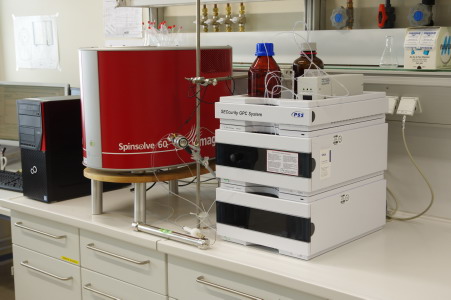
This characterization method allows to analyze blends or copolymers not only for their average composition. It delivers the full composition as a function of the size of the molecule. For further information please see the page in the research areas "Low-field-NMR and SEC"
Keyence Digital microscope VHX 900F [start of operation June 2017]

The microscope will be used in projects like foaming of model polymers or nanoparticle-hydrogels where the optical impression is needed to judge the success of a synthetic approach.
Haake Minijet Pro [start of operation march 2017]
 The Haake Minijet Pro is a injection molding machine for lab scale, starting from sample amounts as low as 2 ml. Our system is equipped with several geometries, including specimens according DIN regulations and simple platets for rheological experiments. In combination with the Haake MiniLab, an extruder in lab scale (see left side of picture), we can produce also composites or blends.
The Haake Minijet Pro is a injection molding machine for lab scale, starting from sample amounts as low as 2 ml. Our system is equipped with several geometries, including specimens according DIN regulations and simple platets for rheological experiments. In combination with the Haake MiniLab, an extruder in lab scale (see left side of picture), we can produce also composites or blends.
Therefore, this new equipment offers the possibility for test specimens even for small amounts available, e.g. for our self-synthesized model polymers.
Capillary rheometer Göttfert Rheograph 50 [start of operation oct 2016]
This new capillary rheometer is a big improvement compared to the existing older model from the same company.
With this system, one can examine extremely high shear rates up to 6 Mill s^-1. This is enough to simulate conditions in polymer processing as well as for lubricants in mechanic engines.
In addition, this rheometer can cool and heat, so one can measure food, e.g. chocolate at realistic conditions.
Also PVT-Measurements can be performed. The relation between pressure, volume and temperature is an established method for measuring material compressibility under processing conditions, an information necessary for the optimization of cylce times in polymer processing, especially in injection moulding.
Magritek Spinsolve 60 MHZ NMR spectrometer [start of operation oct 2016]
The Magritek Spinsolve 60 NMR spectrometer sets a new standard for 60MHz benchtop NMR
instruments. The Spinsolve 60 spectrometer provides high quality 1H NMR spectra in seconds and is based on permanent magnets, therefore no liquid nitrogen or helium is needed for the operation.
The main idea for this spectrometer is the usage in combination with GPC as the Magritec is also able to measure samples in flow. With this combination, we plan to build up a two dimensional charaterisation GPC-NMR, with size resolution due to the GPC and chemical information due to the NMR.
Cooling Unit for Anionic Synthesis [Start of operation october 2015]
This new equipment on the anionic schlenk line allows synthesis at temperatures down to -70°C without the use of liquid nitrogen.
Therefore, extremely long synthesis duration are possible as there is no danger of lack of nitrogen. In addition, the temperature can be controlled more exactly, more defined synthesis conditions lead to better defined polymers.
Hygromator, Add-on DMTA [Start of operation Jan 2015]
The Hygromator allows measurement of mechanical properties under defined humidity. This is absolutly necessary for our research on hydrogels. Here we try to optimize mechanical properties for hydrogels to use them later on for water desalination. As the mechanical properties are drastically dependend on the swelling degree, drying of the hydrogels has to be avoided to receive reliable measurements.
Texas Instruments DHR1 [start of operation june 2014]
Similar system to the already existing DHR3: Also the DHR1 is extremely sensitive in terms of measurable torque due to its magnetic bearings. Minimum torque is 0.1 nNm, measurements of liquids are therefore no problem for this machine.
With this equipment, the practical course has now actual modern equipment also for rheology.
Haul-Off (Add-on Capillary rheometry) [Start of operation June 2013]
Device: Haull-Off (Goettfert) (right side of picture), a additional module for the capillary rheometer to create high extensional flow in polymer melts. The Haul-Off is a Add-On especially useful for fiber spinning processing operation. It is designed as an accessory for Göttfert’s line of capillary rheometers (can however be readily adapted on other extruder machines) It's pulley system draws the pre-sheared extrudate exiting the capillary rheometer at constant extension rate (speeds up to 6000 mm/s) In Combination with the Rheotense (left side in picture), the group is now fully equipped to simulate spinning processing conditions.
New Rheometer DHR3 [start of operating april 2012]
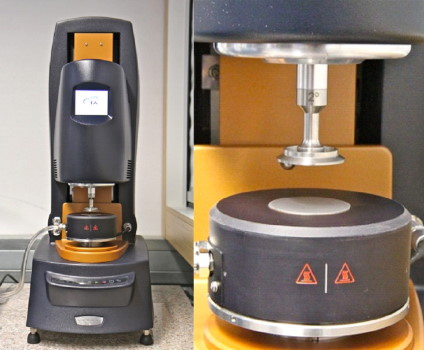 For the first time the new controlled stress DHR3 rheometer from TA Instruments is installed at a European University. It is our most sensitive rheometer in terms of torque and displacement. Equipped with magnetic bearing, double optical encoder for the deformation and a force rebalance transducer, the DHR3 offers a minimum detectable torque resolution of about 0.05nNm and a displacement of 2nrad. The available Peltier element offers a range of temperatures from 40°C to 200°C.
For the first time the new controlled stress DHR3 rheometer from TA Instruments is installed at a European University. It is our most sensitive rheometer in terms of torque and displacement. Equipped with magnetic bearing, double optical encoder for the deformation and a force rebalance transducer, the DHR3 offers a minimum detectable torque resolution of about 0.05nNm and a displacement of 2nrad. The available Peltier element offers a range of temperatures from 40°C to 200°C.
Rheotens: Extensional flow [start of operation Nov 2011]
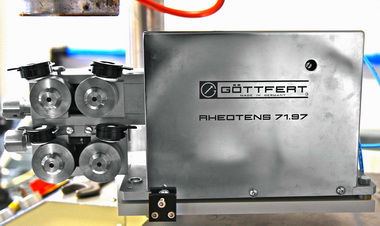 Device: Rheotens (Goettfert), a additional module for the capillary rheometer to create and quantify extensional flow in polymer melts.
Device: Rheotens (Goettfert), a additional module for the capillary rheometer to create and quantify extensional flow in polymer melts.
The Rheotens in a type of extensional rheometer for polymer melts produced by Göttfert. It is designed as an accessory for Göttfert’s line of capillary rheometers (can however be readily adapted on other extruder machines) and emulates a fiber spinning processing operation. It’s tandem pulley system draws the pre-sheared extrudate exiting the capillary rheometer at constant extension rate (speeds up to 1900 mm/s, maximum acceleration of 3200 mm/s2). In addition, the system provides the force exerted during the operation (0 to 2 N at a resolution of 0,001 N). In this way, the elongational viscosity is computed using a procedure developed by Prof. M. Wagner (then University of Stuttgart). In our laboratory, the Rheotens is also adapted to our high sensitivity slit extrusion dies on our capillary rheometer and extruder (in this case combined with a low field NMR) in relation to the development of instabilities and crystallization in forced extrusion systems.
Zeta-potential measurement [start of operating March 2011]
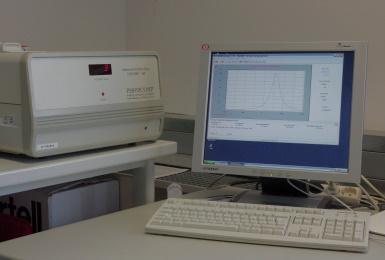 Decive: Nicomp 380 DLS from Particle Sizing Instruments (PSS), additionally equipped with modul for zeta potential measurement, both classical and phase shift modus for high sensitivity. High voltage cell for organic solvents and normal cell for water-based solvents included, temperature range identical to the dynamic light scattering, e.g. 5 °C to 80 °C.
Decive: Nicomp 380 DLS from Particle Sizing Instruments (PSS), additionally equipped with modul for zeta potential measurement, both classical and phase shift modus for high sensitivity. High voltage cell for organic solvents and normal cell for water-based solvents included, temperature range identical to the dynamic light scattering, e.g. 5 °C to 80 °C.
Zeta-potential is important for charged colloidal systems where it offers a chance to characterize the amount of charges connected directly to the stability of the collloidal system. Another aspect is surface chemistry, when fucntional groups on the surface of colliodal particles are introduced or replaced by different groups.
Static Light Scattering and dn/dc-measurement [start of operating Jan 2011]
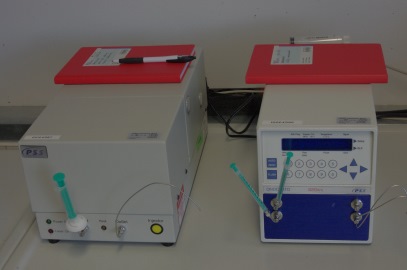 Device: MALLS (multi-angle-laser-light-scattering, BI-MwA from Brookhaven Instruments), DnDc2010 (PSS, particle standard service, Mainz), both temperature range from +5 °C to 80 °C, cells usuable for a wide spectrum of solvents including most common organic solvents.
Device: MALLS (multi-angle-laser-light-scattering, BI-MwA from Brookhaven Instruments), DnDc2010 (PSS, particle standard service, Mainz), both temperature range from +5 °C to 80 °C, cells usuable for a wide spectrum of solvents including most common organic solvents.
With this new equipment we can perform static light scattering of polymer solutions (e.g. Zimm-diagram: Molecular weight and radius of gyration) in short measuring times and independent from the solvent. This can be used to control molecular weights obtained by SEC (Size exclusion chromatography) and as a molecular weight determination method for every solvent, also these not available in SEC. The determination of dn/dc-values is a requirement for static light scattering, but will also increase the applications for the coupled SEC-MALLS detection.
Haake Minilab for extrusion [start of operating July 2010]
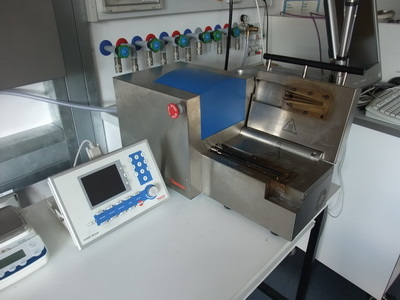 The Haake Minilab (Thermo Scientific, Karlsruhe) is a extruder for small amounts of extrudate starting from 5 g. In addition, it is equipped with co- and with counterrotating twin screws to allow different qualities of mixing. One interesting point is the automatic bypass operation for circulation/extrusion as needed by the operater.
The Haake Minilab (Thermo Scientific, Karlsruhe) is a extruder for small amounts of extrudate starting from 5 g. In addition, it is equipped with co- and with counterrotating twin screws to allow different qualities of mixing. One interesting point is the automatic bypass operation for circulation/extrusion as needed by the operater.
The Minilab is of high importance for our research as it offers the possibility to produce nanocomposites of polymers and mostly anorganic nanoparticles, an important field in actual materials science we intend to work on in future.
Second Vacuum line for anionic synthesis [start of operating june 2010]
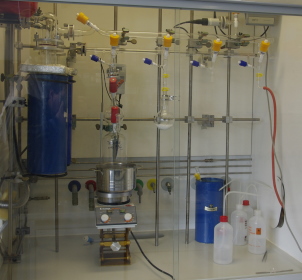
In Cooperation with the Max-Planck-Institute for Polymer Science in Mainz we construted a second vacuum-line for anionic synthesis shown in the picture at the left side.
Due to to our synthetic capacities, a second vacuum line was necessary. The second lines also offers us the possibility to include the anionic synthesis in the practical course for the education of students.
New Rheometer Ares G2 [start of operating october 2009]
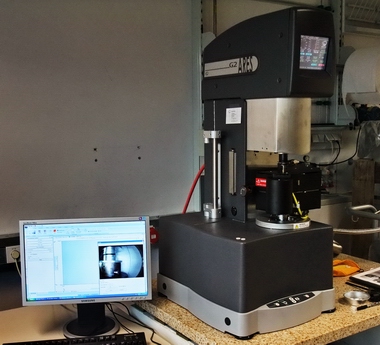
Device: Complete System from TA-Instruments, with sample geometries for liquids and melts, oven with digital monitoring of sample, temperature range between -70 °C and 400 °C.
Rheology is one of the basics methods for the research fields of our group. This Rheometer of the latest generation overs sererval new possibilities for our research.
The temperature range of the new oven (-70 °C up to 400 °C) offers the possibility to characterize also high temperature polymers not possible to measure with the older version of the ARES rheometer.
The sensitivity of the new rheometer covers an extremely high range starting from 0.05 µN/m to 200 mN/m offering a factor of 8 for low torque measurements and a factor of 2 for high torques compared to the old ARES. Therefore, it offers the possibility to measure low-viscosity liquids as water as well as special polymers with high stiffness.
The frequency range is improved from 16 Hz to 100 Hz, offering a wider range for non-linear measurements, e.g. FT-Rheology, an important topic in our research. Excitation at high amplitudes and/or high frequencies result in a non-linear answer of the material that is analysed via FT-Rheology in our group. This non-linear method has been developed in our group and is integrated in the new rheometer due to a cooperation with TA-Instruments.
Small angle X-ray scattering [start of operating october 2009]
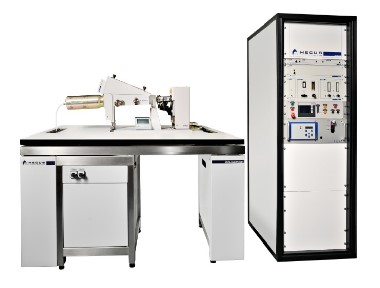
Due to start up money from the Barner-Kowollik group and in a joint effort with them we are happy to have the possibility to perform small-angle X-ray scattering (SAXS)
Device: Complete System from Hecus (Hecus X-ray Systems GmbH, Graz) with point-focus optics including one-dimensional and two-dimensional dectector and a big variety of sample holders, offering a possible temperature range between -20 °C to 300 °C.
SAXS (Small-angle X-ray scattering) is one of the basic characterisations methods for polymer science and nano-structered materials, e.g. colloids. It is suited for structures under examination varying between 1 nm and 500 nm, offering in-situ characterization of solution structure.
There are two main fields where we want to use this new characterization method: Structure in solution and Ordering in polymer melts and solids. In Solution, one can determine the size, the shape and, if existent, the internal structure of molecules or of supramolecular aggregates also including information about interaction of particles or molecules. In melt the ordering is the point of main interest, here the point focus combined with the two-dimensinal detection allows the characterization of ordered structures.
Additional, the new X-ray-system offeres two possibilities to characterize surfaces: X-ray reflectrometry with an additional detector and grazing incidence SAXS (GISAXS) using a special sample holder.
Vacuum line for anionic synthesis [start of operating september 2009]
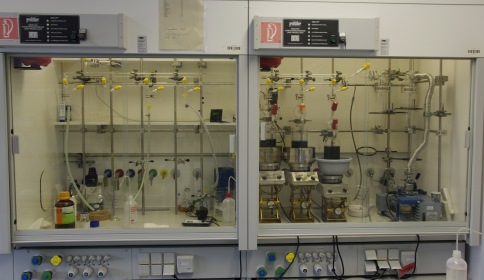
In Cooperation with the Max-Planck-Institute for Polymer Science in Mainz we construted a new vacuum-line for anionic synthesis shown in the picture at the left side.
This vacuum lines allows us to clean up to six different solvents/monomers and use them in different reaction steps in one synthesis. Anionic synthesis is important for our group as it allows the synthesis of well defined model polymers with high molecular weight and a extremely narrow molecular weight distruibution.
Another advantage of anionic polymerization is the living character of the reaction. Therefore, combining several homopolymers to complicated topologies can be realized. We intend to use the anionic synthesis for block copolymers to examine the phase separation and for comb-polymers as model system for branched polymers usual in industrial system.
Triple Detection SEC [start of operating april 2009]
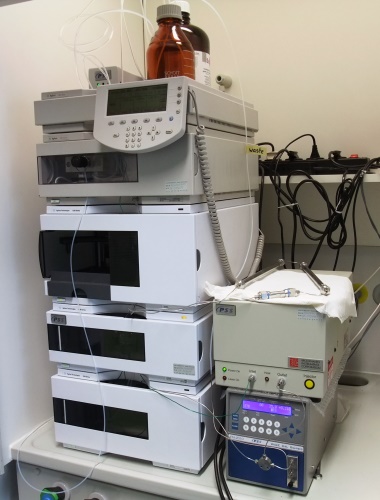 Device: Complete System from PSS (Polymer Standard Service): Software and Columms from PSS (Polymer Standard Service), Agilent 1200 Series (Sample changer, UV-detector, RI-detector, pump), Viscositydetector (ETA2010, WGE Dr. Bures) and MALLS (multi-angle-laser-light-scattering, BI-MwA from Brookhaven Instruments)
Device: Complete System from PSS (Polymer Standard Service): Software and Columms from PSS (Polymer Standard Service), Agilent 1200 Series (Sample changer, UV-detector, RI-detector, pump), Viscositydetector (ETA2010, WGE Dr. Bures) and MALLS (multi-angle-laser-light-scattering, BI-MwA from Brookhaven Instruments)
SEC (Size-Exclusion-Chromatography, GPC Gel-Permeations-Chromatographie) is one of the basic characterisations methods for polymer science offering the posibility of determination of not only the mean average of the molecular weight , but also the distribution of a polymeric sample. Standard-SEC uses a concentration detector (signal only dependent on the concentration), typically a RI (refractive index) or a UV-detector.
For the determination, a calibration against a serie of standards, usually linear polystyrene, is necessary. For samples differing from the availabe standards, problems arise. Here one can use a universal calibration with known staudinger index of the sample, but literature values are normally not relialabe enough.
Here the triple-detection is an important improvement. It offers two possibilities for measuring unknown samples: The viscosity detector allows a simultaneous determination of the staudinger index and therefore the use of the universal calibration, the light scattering detector allows a direct determination of the molecular weight without any calibration and in addition, a measurement for the size of polymers in solutions, the radius of gyration.
This advanced method is useful for new synthesized polymers with new chemistry or new topology. In our institute, it will be used to characterize special topologies of polymers, e.g. comb structure (Prof. Wilhelm) and star polymers (Prof. Barner-Kowollik).


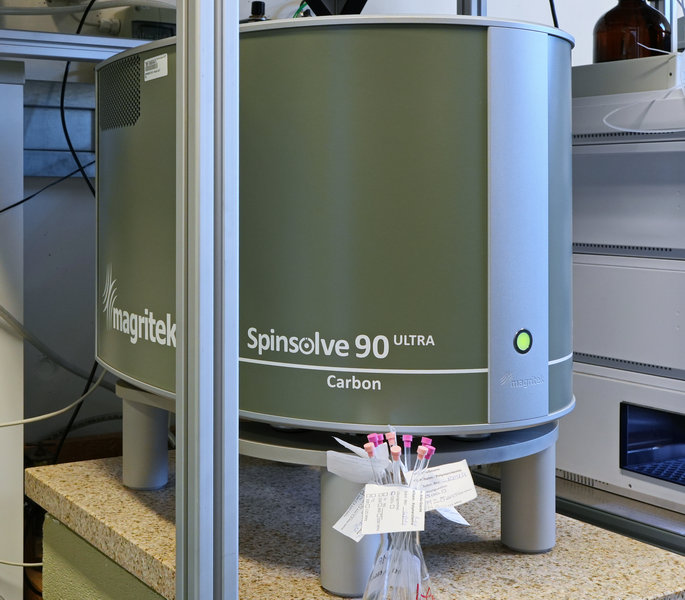
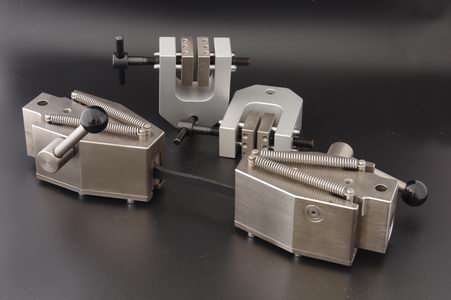 al tensile testing machine 10kN from Hegewald & Peschke
al tensile testing machine 10kN from Hegewald & Peschke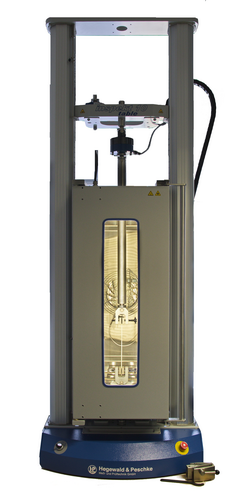 Suitable for polymer testing:
Suitable for polymer testing: Our batch reator is an custum build SFT-High Pressure Reactor from Supercritical Fluid Technologies.
Our batch reator is an custum build SFT-High Pressure Reactor from Supercritical Fluid Technologies.